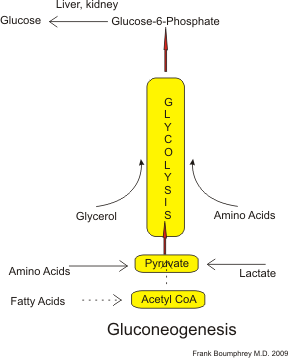Structural Biochemistry/Gluconeogenesis
Background Information
[edit | edit source]
Gluconeogenesis is a process, in which Pyruvate (a product of Glycolysis) is backward-converted into sugar, glucose in particular. Which can then be stored in the form of glycogen in animals' cells or starch and cellulose in plants' cells.
Process
[edit | edit source]There are three basis steps involved in Gluconeogenesis:
- Pyruvate to Phosphoenolpyruvate (PEP):
- The enzyme pyruvate carboxylase converts pyruvate into oxaloacetate by adding the CO2 from the bicarbonate ions with the support of ATP and the coenzyme biotin.
- Then oxaloacetate is converted into phosphoenolpyruvate (PEP)by the enzyme PEP carboxykinase in a process that uses GTP (guanosine triphosphate) as energy and releases CO2 as a waste product. Note that the released CO2 is actually the same CO2 molecule from the bicarbonate ion at the previous step.
- The next steps are just the reversed processes of glycolysis going from PEP back to Fructose 1,6-bisphosphate, with released products in glycolysis being reactants/cofactors in gluconeogenesis.
- Fructose 1,6-bisphosphate (Fru 1,6-P) to Fructose 6-Phosphate (Fru 6-P): This is an irreversible hydrolysis reaction catalyzed by the enzyme Fructose 1,6-bisphosphatase (FBPase-1). This reaction is heavily regulated by Fructose 2,6-bisphosphate.
- Glucose 6-Phosphate to Glucose: Fru 6-P in the previous step is converted into Glucose 6-Phosphate by reversed step of glycolysis. Glucose 6-phosphate is converted into glucose by a hydrolysis reaction.
Regulation
[edit | edit source]The main regulatory factor is the concentration of Fructose 2,6-bisphosphate (Fru 2,6-P), which controls glycolysis (catabolic pathway) and gluconeogenesis (anabolic pathway).
- First, Fru 2,6-P is the conversion of Fructose 6-Phosphate (Fru 6-P) by the enzyme Phosphofructokinase-2 (PFK-2), which uses ATP as an energy source. This is a reversible reaction, thus the reversed reaction gives back Fruc 6-P. The reversed reaction is catalyzed by the enzyme Fructose 2,6-bisphosphatase (FBPase-2) in a process releasing an inorganic phosphate.
- Second, how can Fru 2,6-P regulates glycolysis and gluconeogenesis?
- In a breakdown pathway, because Fru 6-P is readily phosphorylated into Fru 1,6-P by the enzyme Phosphofructokinase-1 (PFK-1), a high concentration of Fru 2,6-P will accumulate and promotes the activity of PFK-1 and inhibits FBPase-1. Note that PFK-2 is active and FBPase-2 remains inactive to stimulate the production of Fru 2,6-P
- In the synthesis pathway, Fru 6-P concentration rises, inhibits the activity of PFK-2, and stimulates FBPase-2 to reduce the concentration of Fru 2,6-P. As the concentration of Fru 2,6-P decreases over time, the activity of PFK-1 also decreases, thus stimulating FBPase-1 to convert Fru 1,6-P into Fru 6-P,which is later ultimately converted into glucose.
Note that in the case of low glucose level in the blood: the enzyme glucagon from liver can stimulate the production of an enzyme called cAMP-dependent protein kinase, which stimulates the conversion of the PFK-2 (active)/FBPase-2 (inactive) into PFK-2 (inactive)/FBPase-2 (active). This process will inhibit glycolysis and promote gluconeogenesis to pump more glucose from liver into the blood.
